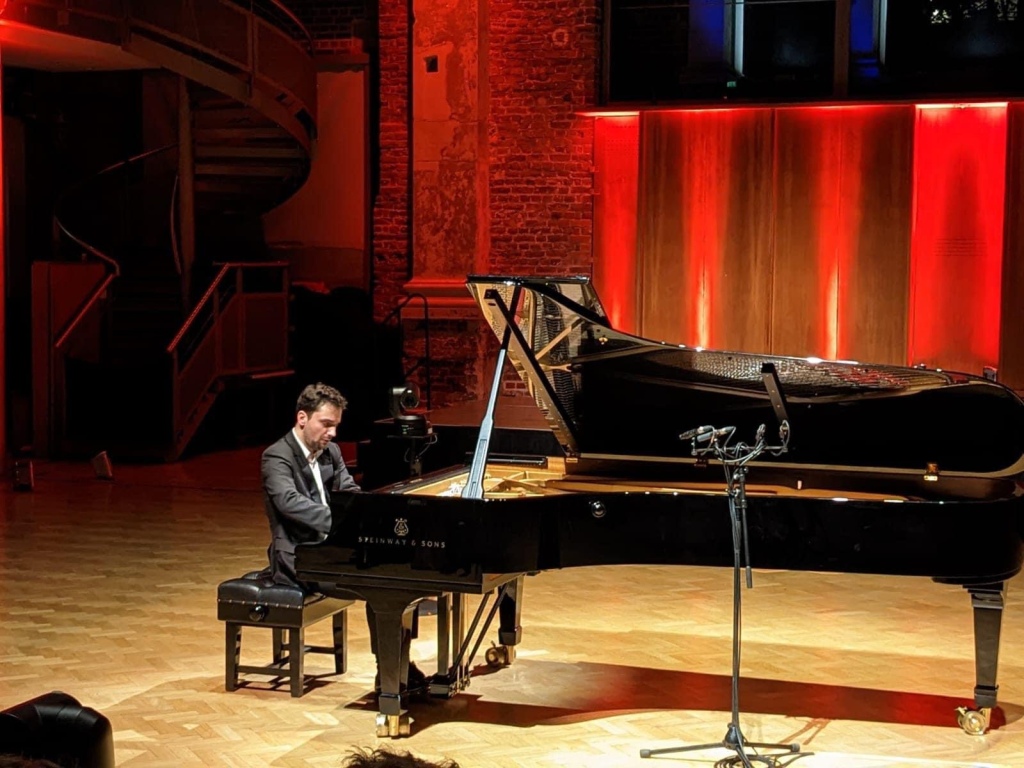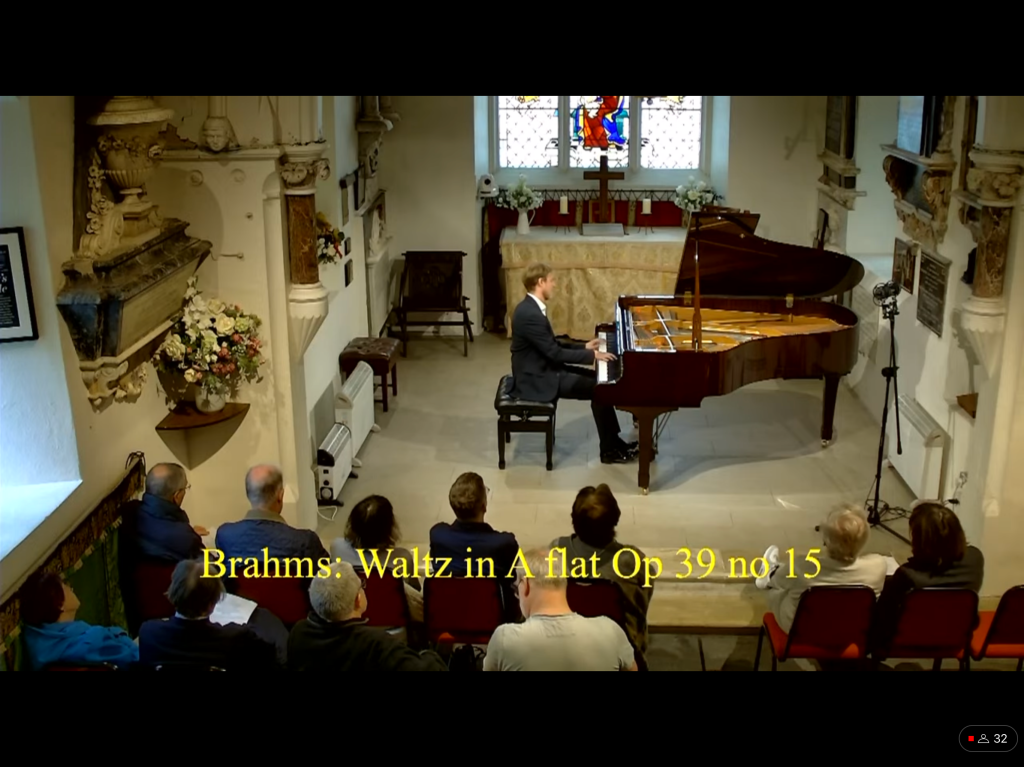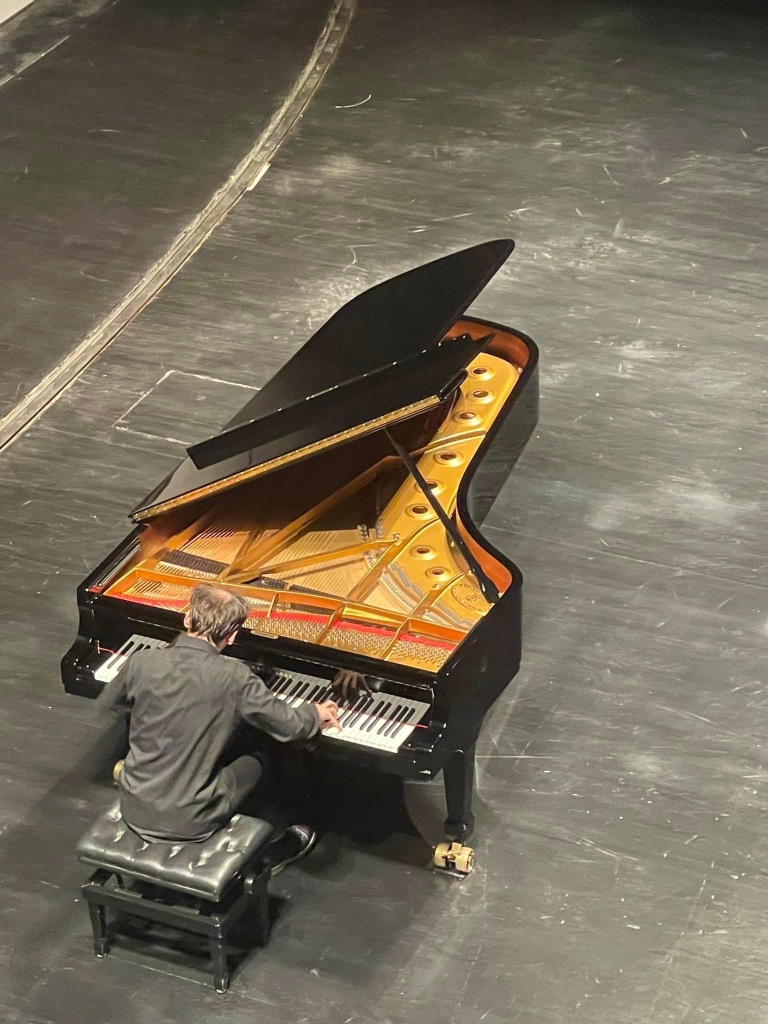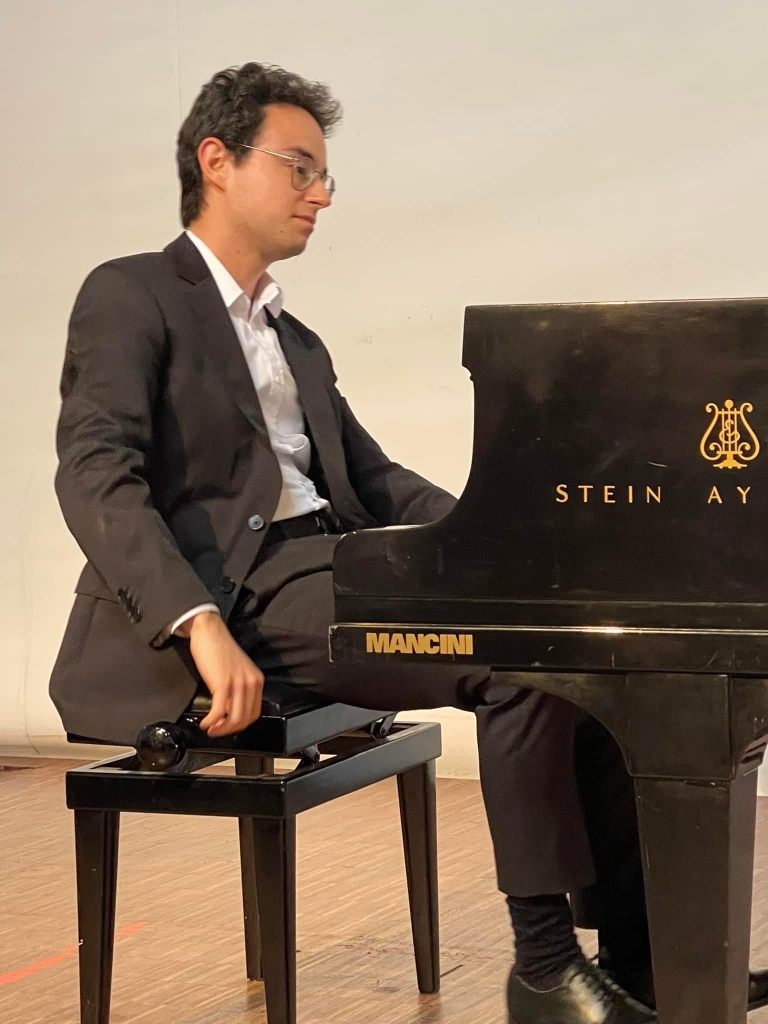
Wolfgang Amadeus Mozart
Sonata in C minor K457 Allegro – Adagio – Allegro assai
Dmitrii Shostakovich
Four Preludes op. 34 1. Moderato – 6. Allegretto – 10.Moderato non troppo – 24. Allegretto
Interval
Johannes Brahms
Variations on an Original Theme op. 21 No. 1
Johannes Brahms
Variations on a Hungarian Song op. 21 No. 2

Parvis Hejazi in recital with Mozart,Shostakovich,Brahms .Some remarkable musicianly performances from a true artist.Always a great showman but one who has learnt that the message of music is the greatest show that one can share.A performance of Mozart C minor Sonata that was both dramatic and tender.
Early Shostakovich Preludes with their sometimes grotesque sense of humour but that spoke as eloquently as Prokofiev’s poetic Visions Fugitives.
But it was the Brahms variations op 21
n.1 and 2 that unleashed the depth of sound and ravishing sense of colour from this young poet of the piano,together with his aristocratic sense of harmonic structure.
It gave great weight and meaning to these sumptuous scores of passionate pulsating harmonic blocks of ever moving romantic effusions.
A single encore of Couperin who’s sublime simplicity was the ideal antidote to Brahms’s passionate effusions and the allusion to the Mysteries of Bacchus led very nicely to the post concert drink.

The Piano Sonata No. 14 in C minor K.457, was composed and completed in 1784, with the official date of completion recorded as 14 October 1784 in Mozart’s own catalogue of works.It is dedicated to Theresia von Trattner (1758–1793), who was one of Mozart’s pupils in Vienna. Her husband, Thomas 1717–1798), was an important publisher as well as Mozart’s landlord in 1784. Eventually, the Trattners would become godparents to four of Mozart’s children.It was composed during the approximately 10-year period of Mozart’s life as a freelance artist in Vienna after he left the patronage of the Archbishop of Salzburg in 1781 and is one of the earliest of only six sonatas composed during the Vienna years.It is only one of two sonatas Mozart wrote in a minor key, the other being the the A minor K.310 which was written six years earlier, around the time of the death of Mozart’s mother.He was extremely deliberate in choosing tonalities for his compositions; therefore, his choice of C minor for this sonata implies that this piece was perhaps a very personal work.Kochel said of this sonata, “Without question this is the most important of all Mozart’s pianoforte sonatas. Surpassing all the others by reason of the fire and passion which, to its last note, breathe through it, it foreshadows the pianoforte sonata, as it was destined to become in the hands of Beethoven “The last movement is unlike many of Mozart’s sonatas’ last movements, which tend to have fast tempo and joyfulness and happiness. This movement contains a great tragic sense that really makes it stand out.

The 24 Preludes, op.34 is a set of short piano pieces written and premiered by Shostakovich in 1933. They are arranged following the circle of fifths with one prelude in each major and minor key.He began composing the preludes in December 1932, shortly after finishing his opera Lady Macbeth .He completed the cycle in March 1933, and premiered it in Moscow himself in May of the same year.He composed the preludes largely in order to return to public performance as he had stopped performing in 1930, after his failure to be placed at the 1927 First International Chopin Competition.The preludes are intimate and brief forming a link to Shostakovich’s next work, the Piano Concerto No 1 (for piano, trumpet and strings), which he began just four days after completing the preludes.Each prelude shows that Shostakovich was able to distil his genius into the shortest time span, as well as, of course, he would prove able to explore on the largest scale in his next work, the fourth symphony.

Brahms began his career as a pianist. His contribution to the piano music of the 19th century is significant in two respects: following Schubert and Schumann he cultivated the small, lyrical form, while as Beethoven’s successor he admitted large forms such as the piano sonata and variation cycle. His two variation cycles op. 21, published in 1862, place great demands on the performer. In the first cycle, on a lyrical theme in D major, the technique of figurative and contrapuntal alterations is highly developed. The “Variations on an Original Theme” although published as “No. 1,” as a set of independent piano variations–the only one on a theme of Brahms’s own devising–was certainly composed a few years later than the ‘Hungarian song ‘ set published as “No. 2.” The two sets work well when performed together, as they share a central key. The Hungarian Song op 21 n.2 was composed as early as 1853, thus even predating the “Schumann” variations op 9 .The “Hungarian Song” was given to Brahms by his violinist collaborator Eduard Reményi and as used in the variations, the “theme” is a brief, vigorous eight bars. Its distinctive aspect is the alternation between 3/4 and 4/4 bars, a typical example of Eastern European mixed meter. The ‘Hungarian Song ‘set can function as an extroverted “encore” to the more introspective and longer “Original Theme” set. The “Variations on an Original Theme” were probably composed in the late 1850s, partly as an exercise in variation technique. Brahms set several challenges for himself in devising the theme. The irregular lengths of each repeated half–nine bars each–remain mostly consistent through the variations, lending stability and recognition as other elements range farther from the theme.

Les Barricades Mystérieuses (The Mysterious Barricades) by Couperin for harpsichord and was composed in 1717. It is the fifth piece in his “Ordre 6ème de clavecin” from his second book of collected harpsichord pieces (Pièces de Clavecin).Debussy expressed particular admiration for Les Barricades Mystérieuses and in 1903 wrote: ‘We should think about the example Couperin’s harpsichord works set us: they are marvelous models of grace and innocence long past. Nothing could ever make us forget the subtly voluptuous perfume, so delicately perverse, that so innocently hovers over the Barricades Mystérieuses.’The title is probably meant to be evocative rather than a reference to a specific object, musical or otherwise.It has suggested that, in keeping with the bucolic character of other pieces in Couperin’s Ordre 6ème de clavecin, the pounding rhythm may represent the stamping of grapes in winemaking (given that the French word barrique means ‘barrel’, and barriquade was a designation adopted by viticultualists of the day in France).In this view, the “mysterious” epithet could allude to the significance of wine in the Mysteries of Bacchus.

Parvis Hejazi is known as a “rising star on the piano sky” (ARD), and “a poet and virtuoso at the piano” (Christopher Axworthy). Playing his debut at the Salzburg Festival aged 16, Parvis has performed throughout Europe, the Middle East, and the US at venues such as the Laeiszhalle Hamburg, Die Glocke Bremen, and the Gnessin Institute Moscow. Having won more than 30 first prizes in national and international competitions, Parvis has received coverage by ARD, NDR, and HR, and in foreign and domestic print media. Parvis is a graduate Scholar of the Royal College of Music, where he currently pursues a Master of Music, studying with Norma Fisher and Vanessa Latarche. In autumn, Parvis will commence his studies on the prestigious Artist Diploma programme at the College on a full scholarship. A Member of the Keyboard Charitable Trust and Talent Unlimited UK, Parvis holds the Music Talks Award and the Bärenreiter Urtext Award. He is supported by the Evangelisches Studienwerk Villigst, the Karin and Uwe Hollweg Foundation and Susan Sturrock.

































































































































